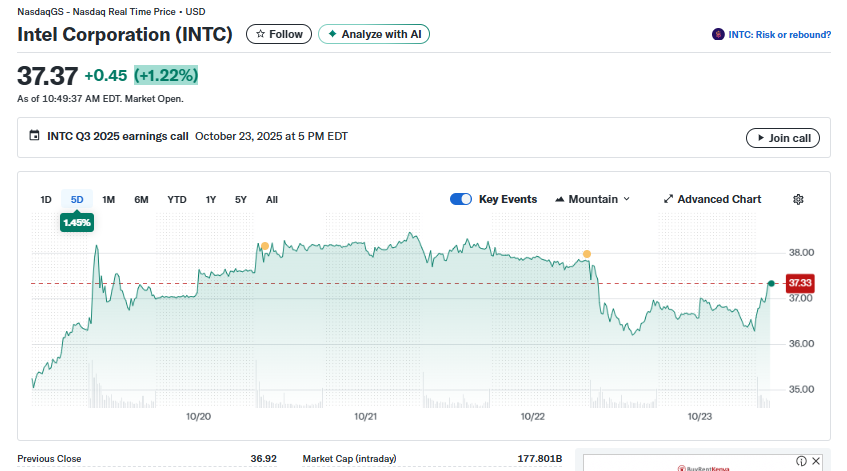TLDRs:
- Intel gains ahead of Q3 earnings as Nvidia, SoftBank, and U.S. government stake deals support financial outlook.
- Analysts warn details on investments are limited, leaving long-term operational impact unclear for Intel.
- Intel continues losing CPU market share to AMD and Arm-based chips despite global PC shipment growth.
- Early reports on Intel 18A processors may create opportunities for design and service firms.
Intel Corporation (INTC) gained on Thursday, rising to $37.34, up $0.42 (+1.14%) as of 10:49 AM EDT, as investors prepared for its Q3 earnings call scheduled for October 23, 2025, at 5 PM EDT.
The surge comes after announcements of major investments from Nvidia, SoftBank, and the U.S. government, totaling $16 billion. Nvidia’s $5 billion deal is expected to secure roughly a 4% stake, SoftBank is contributing $2 billion, and the U.S. government plans a 10% holding through an $8.9 billion investment.
While these deals signal confidence in Intel’s long-term strategy under CEO Lip-Bu Tan, the specifics of how the capital infusion will be allocated remain vague. Analysts caution that uncertainties around timing, governance, and potential dilution could influence Intel’s earnings trajectory.

Revenue Outlook Shows Slight Decline
According to LSEG data, Intel anticipates a modest 1% year-on-year decline in Q3 revenue, totaling approximately $13.1 billion. Forecasts suggest a per-share loss of 22 cents, with adjusted earnings expected around 1 cent per share.
Intel’s PC chip unit is projected to rise 11% in revenue, reflecting steady demand, while its manufacturing segment is likely to remain flat.
Global PC shipments rose 8% in Q3, per Gartner data, yet Intel continues to face stiff competition from AMD and Arm-based CPU producers, which have eroded its market share in both personal computer and server segments.
Big Investments, Limited Details
The announced deals come with sparse disclosure on critical elements. Key aspects such as timing, lockup periods, and intended use of proceeds are still unclear, leaving analysts to question the potential impact on Intel’s operations.
While the U.S. government’s 10% stake and Nvidia’s anticipated 4% position may provide a financial buffer, concerns over possible dilution before year-end add uncertainty to fourth-quarter profitability.
Intel Foundry recently reported a $3.2 billion operating loss last quarter, and its ability to attract major 14A customers will be crucial for sustaining its chip manufacturing ambitions. Nvidia confirmed that it would not be shifting GPU production to Intel, highlighting that strategic investments do not necessarily translate to immediate operational synergy.
Intel 18A Expansion Opens Opportunities
Amid these financial developments, Intel is also preparing for the ramp-up of its 18A process technology. Reports indicate that Microsoft is sampling Intel 18A chips for its Maia 2 data center AI accelerators, although this remains speculative.
Synopsys, a leading Electronic Design Automation (EDA) firm, is providing production-ready design flows compatible with Intel 18A, including IP for 224G Ethernet, PCIe 7.0, and Universal Chiplet Interconnect Express (UCIe). Intel’s Panther Lake PC processors, the first to use 18A, are scheduled for release before the end of 2025.
This expansion may create opportunities for service firms specializing in physical verification, IP porting, and RTL-to-GDSII flows, as teams test the new process for high-performance computing applications.
Investor Takeaway
Intel’s Q3 earnings report will offer clarity on how these major investments and ongoing market pressures intersect with the company’s operational performance.
While stock gains reflect optimism about financial backing, analysts maintain that execution and strategic alignment will ultimately determine whether Intel can regain momentum in a competitive CPU and server landscape.






